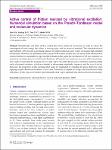Item Infomation
Full metadata record
| DC Field | Value | Language |
|---|---|---|
| dc.contributor.author | Xiao, Ma | - |
| dc.contributor.author | Xinfeng, Tan | - |
| dc.contributor.author | Dan, Guo | - |
| dc.date.accessioned | 2023-04-14T06:36:49Z | - |
| dc.date.available | 2023-04-14T06:36:49Z | - |
| dc.date.issued | 2022 | - |
| dc.identifier.uri | https://link.springer.com/article/10.1007/s40544-022-0651-4 | - |
| dc.identifier.uri | https://dlib.phenikaa-uni.edu.vn/handle/PNK/7938 | - |
| dc.description | CC BY | vi |
| dc.description.abstract | Superlubricity and active friction control have been extensively researched in order to reduce the consumption of fossil energy, the failure of moving parts, and the waste of materials. The vibration-induced superlubricity (VIS) presents a promising solution for friction reduction since it does not require high-standard environment. However, the mechanism underlying the VIS remains unclear since the atomic-scale information in a buried interface is unavailable to experimental methods. In this paper, the mechanism of VIS was examined via numerical calculation based on the Prandtl—Tomlinson (PT) model and molecular dynamics (MD) simulations. The results revealed that the pushing effect of stick—slip is one of the direct sources of friction reduction ability under vibrational excitation, which was affected by the response amplitude, frequency, and the trace of the tip. | vi |
| dc.language.iso | en | vi |
| dc.publisher | Springer | vi |
| dc.subject | vibration-induced superlubricity | vi |
| dc.subject | molecular dynamics | vi |
| dc.title | Active control of friction realized by vibrational excitation: Numerical simulation based on the Prandtl-Tomlinson model and molecular dynamics | vi |
| dc.type | Book | vi |
| Appears in Collections | ||
| OER - Kỹ thuật điện; Điện tử - Viễn thông | ||
Files in This Item:

